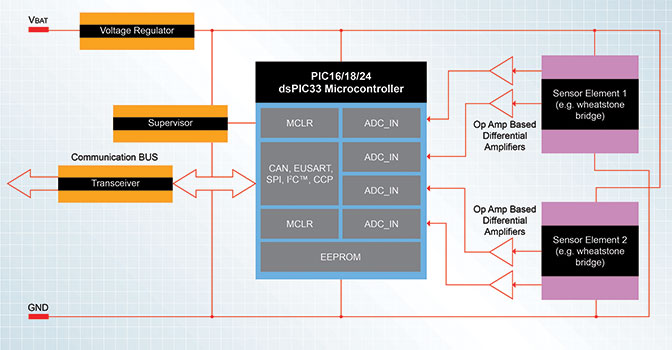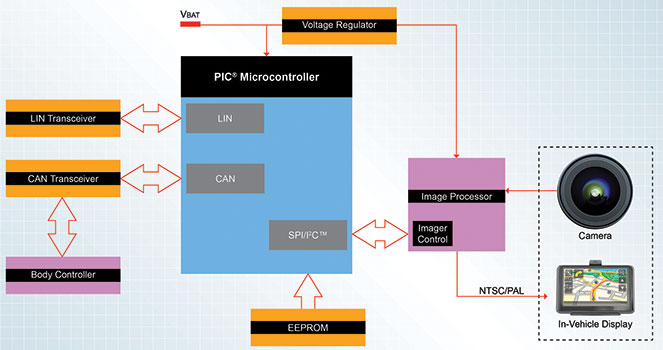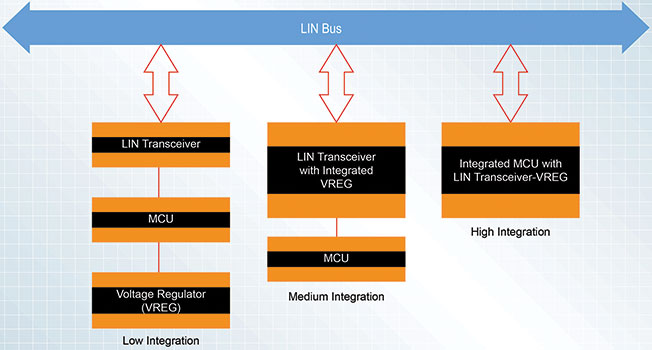
Throughout a modern vehicle there is a requirement for using small 8- or 16-bit microcontrollers in many applications, from position sensors to controlling the windscreen wipers. For example, the need for angular position sensing becomes increasingly important as this capability is needed for applications such as brushless DC motor control, pedal positioning control, steering angle sensing control and rotary switches in the human-machine interfaces.
The angular position sensor control system analyses the data received from sensors and determines the appropriate angular rotation. Four primary sensing technologies used to measure the angular position in automotive applications are optical sensors, potentiometers, magneto-resistive sensors and Hall-effect sensors.

Vision systems too are expanding in the vehicle to provide a safer driving experience. Whether it’s rear camera vision, parking assistance, side object detection or lane departure warning, the information from the vision sources is processed and presented to the driver on displays, via audible tones or a combination of both. In a rear camera vision system, the cameras serve as sensors monitoring the driving conditions and the inputs are processed and provided to the driver for viewing.

The CAN and LIN buses are also an area where microcontrollers can help. The CAN bus can be made deterministic and fault-tolerant, and transfers data at speeds up to 1 Mbps. For example, Microchip has a line of products for embedded CAN applications, including standalone controllers, transceivers, and 8- and 16-bit microcontrollers and digital signal controllers with integrated CAN controllers. LIN can be implemented on any PIC microcontroller with a USART interface. The company also has a robust physical layer interface, data link layer implementation, LIN compliant drivers and various development aids including a LIN reference design.

Such microcontrollers can also be used for providing an electronic compass that can be combined with the auto dimming of the rear view mirrors to increase driving safety. The compass system determines the direction in which the car is heading as it senses the absolute position and the change in direction of the car using the earth’s magnetic field as a reference. The direction can be displayed using a low-end segmented LCD integrated with the auto dimming rear view mirror or with the vehicle’s onboard navigation display. The sensor technology used is commonly either magneto-resistive or inductive sensors.
However, the instrument cluster is becoming the focal point for displaying critical information along with the status of various systems within the car. In low-end cluster designs for emerging markets, a combination of gauges and segmented LCDs are used to communicate speed, tachometer, fuel level, oil pressure, battery voltage and engine temperature to the driver. Here again, microcontrollers such as the PIC range can help.
The designer can choose a microcontroller with sufficient performance to support zero position detect for stepper motor controlled gauges without compromising the need for high performance, real-time control and low power consumption. Zero position detect is used to determine the default start-up position and to calibrate the stepper motors. On-chip PWMs can be used for microstepping the stepper motors. The integrated PWM modules allow for easy implementation of the microstepping algorithm to simplify the design.
A microcontroller can also be used as part of an LED ambient module to control an integrated RGB LED, enabling colour and brightness control. With this design, interior ambient lighting is no longer monotonic. Adjustable multicolour LEDs can provide passengers with a more personalised ambient lighting experience. The small size of LEDs also makes implementing lighting in small spaces easier.
Smart actuators are actuators that use microcontrollers to perform intelligent tasks. They are being used more and more in the automotive engine environment to enhance fuel efficiency, improve reliability and reduce cost. They can be found in applications such as turbocharger waste gates and EGR valves.
Keyless entry
There are two types of keyless entry systems: passive and remote. Remote keyless entry enables the locking and unlocking of the car doors without having to insert a key into the door lock of the car. By depressing the button on the key fob, an encoded ultra high frequency (UHF) signal is transmitted to the receiver module in the car. The receiver module authenticates the signal. Upon positive recognition, it instructs the ECU to toggle the lock.
Passive keyless entry lets the user unlock a car door without pressing any buttons. The module inside the door initiates communication by sending out a signal between fixed time intervals to search for the paired key fob. When close, the key fob sends back an acknowledgment signal. Upon positive authentication by the receiver block, it signals the car door to be unlocked.
A low frequency transmission signal needs to be generated by the module in the car door. This can be achieved using the internal PWM module available on several small microcontrollers such as Microchip’s PIC12, PIC16 and PIC18. To perform the filtering and decryption on the receiver end, standalone and integrated analog front end devices are available in small 8- or 16-pin packages to conserve space on the key fob.
For UHF communications between the fob and the receiver module in the door, Microchip can provide transmitters that allow the user to perform frequency or amplitude shift keying modulation to generate the transmissions. Corresponding receivers are available to perform the filtering and decryption of the wireless data.
Two wheels
It is not just in cars that microcontrollers find application. Scooters, motorcycles and mopeds commonly use an engine ignition system based on the capacitive discharge method. This uses the energy transferred from the magneto to a storage capacitor. When released, a high voltage pulse goes via a step-up transformer to a spark plug that ignites the fuel mixture inside the cylinder. The user can monitor the speed of the engine to calculate the accurate timing for the spark, which increases engine efficiency, saves energy and reduces emissions.
Microcontrollers enable a broad array of on-chip peripherals that provide the system designer with flexible options for addressing the requirements of such a system. For example, the speed of the engine can be monitored electronically with a microcontroller that also provides accurate timing for the spark. The ignition spark can be made to occur anytime for a particular engine speed, allowing ignition angle customisation for different engine designs that support the requirements of improved fuel efficiency and reduced emissions.
Windscreen wipers
Wiper controller systems provide a good example of how microcontrollers can be used. The system controls the windshield wiper motor and the washer fluid pump, and can deliver further intelligence using LIN to interact with the rain sensor and stalk switch. The bidirectional communications via a LIN gateway enable better system control and diagnostics capability.
The PIC16 and PIC18 microcontrollers have on-chip peripherals for providing more intelligence in the wiper systems. As the wiper systems move beyond dumb motors moving the wiper blades, the requirements for increased intelligence and connectivity must be addressed by the system designer.
Because of the small footprints, the micro-controller can be integrated directly into the motor housing without compromising functionality, while also supporting a path to allow system weight reduction. With on-chip peripherals to support LIN protocols, the designer can choose the appropriate microcontroller and LIN transceiver that matches the overall system requirements.
Conclusion
The spread of applications is both wide and increasing in today’s vehicles. As car manufacturers move to add more intelligence and connectivity into their products, this use will continue to grow. The flexibility of the 8- and 16-bit microcontrollers shown here allows them to be adapted for many present and future automotive features.
| Email: | [email protected] |
| www: | |
| Articles: | More information and articles about Tempe Technologies |

© Technews Publishing (Pty) Ltd | All Rights Reserved